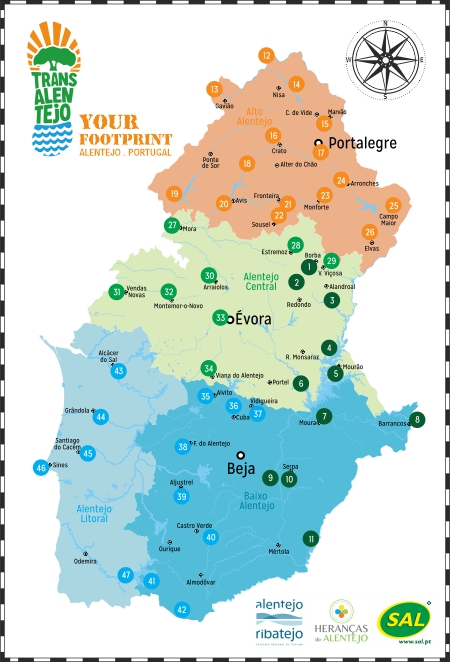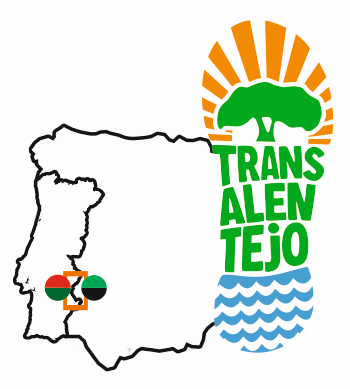 |
|
The
Original Idea and the Story
The
original idea for creating the TransAlentejo Network is absolutely
innovative and structuring.
It all started in 2011 with the structuring thought for the
creation of Great Routes that crossed the Alentejo, connecting
the Spanish routes, which reached the border, and large coastal
routes, parallel to the Atlantic Ocean.
The project was presented at the general assembly of the Associação
Heranças do Alentejo and later to Turismo do Alentejo
ERT.
This
primitive idea had three major weaknesses, typical of
Grand Route structures:
- It was impossible to guarantee coverage of all municipalities
in Alentejo, due to the directional nature of the routes;
- Did not respond to extended periods of accommodation
in the same acommodation, due to the speed of progression
of the walkers;
- There were, and still are, immense connection problems
between the starting and finishing points of the stages,
due to the size of the territory, the geographic dispersion
of accommodation units and the scarce transport services.
This extremely documented project, with well-defined
outlines and a strategy for implementation, promotion
and territorial animation, required improvement and
innovation thinking. |
|
At
the end of 2013, there was new strategic thinking, improving
the original idea, to create a Short Routes Network, abandoning
the idea of Large Routes.
The success requirements have now been met:
- Coverage of all municipalities in Alentejo;
- Possibility of programs with overnight stays in the
same accommodation for several days;
- Circular routes, without the need for transport services
to connect, or linear, accessible at close distances
In 2014, Turismo do Alentejo ERT and Associação
Heranças do Alentejo invited SAL to structure a
pilot project of the 11 TransAlentejo Alqueva Walking
Trails (Borba, Redondo, Alandroal, Reguengos de Monsaraz,
Mourão, Portel, Moura, Barrancos, Beja, Serpa,
Mértola).
The implementation of the TransAlentejo Walking Trails
began. The development of the project had several vicissitudes
that were mainly related to the territorial lack of knowledge
of the tourism product that was being implemented, both
on the part of decision makers and territorial technicians
and by the tourism accommodation chain. |
|
In
order to overcome this difficulty, SAL implemented a strategy
of regular events on the TransAlentejo Pedestrian Routes
with regular walking activities under the Walk in Alentejo
brand.
We made the routes known to participants who walked, to
the accommodation where they stayed, to restaurants in
the region, to everyone who had access to information
through promotional means, to mayors and municipal tourism
technicians and to other companies, associations and groups
of hikers who , then, they followed the same trails and
continued with the process of tourist enrichment of the
territory. |
|
The TransAlentejo Alqueva had the edition of a Route Guide,
with original texts and images, maps produced with attached
and integrated military charts, with high graphic quality, in
a bilingual edition, in Portuguese and English, in a reversible
book system with both versions.

|
This guide was widely disseminated in international
markets, through tourism fairs, meetings with tour operators
and visits to the territory on famtrips and press trips.
At a national level it was sent by mail to many interested
people and distributed at national and regional tourism
fairs, entertainment companies and hikers' associations.
|
Taking into account the innovative aspect and success of TransAlentejo
Alqueva, Turismo do Alentejo ERT, with the support of Turismo
de Portugal, moves forward, in 2017, with the structuring of
all the remaining 36 municipalities in Alentejo in order to
create the only tourist product present throughout the territory.

See the Routes option to download all guides
Again, SAL has the mission of searching, recognizing
and implementing routes in each location, most of which
are original and some incorporated from municipal networks.
This entire process was based on a logic of collective
governance, with local partners from each municipality
involving mayors and tourism technicians, basing the
process on the ESG (environmental, social, governance)
Tourism Sustainability policy.

|
|
In
2020, the TransAlentejo network was structured on the ground,
with the edition of a global map of the Alentejo with location
of the routes and technical sheets for each of them, as well
as three more TransAlentejo Guides with their respective maps
in military chart, for the sub-territories of Alto Alentejo
, Central Alentejo and Baixo Alentejo and Coast.
Throughout
the signage process for the TransAlentejo Walking Trails,
the concept of the greatest possible conservation of the
environment was defined, with pre-existing means always
being used to paint the marks.
This decision avoided excessive costs in structuring,
avoiding supports that are foreign to nature and above
all having the option of never, ever using any type of
plastic signage support in nature (including recycled
ones).
The use of signage using plastic equipment must be completely
banned, preventing the proliferation of microplastics
in the air and waterways during the aging and deterioration
of materials. |
|
In 2021, the TransAlentejo network crossed borders to Spain,
in a pilot project with three new walking routes in Alentejo:
Alandroal, Mourão and Amareleja/Moura, which were twinned
with three existing walking routes in Extremadura(Spain): Olivenza,
Villanueva del Fresno, Valencia del Mombuey, giving rise to
the TransAlentejo Transborder pilot project, which will continue
in the future along the entire Alentejo border line with Extremadura
and Andalucia.
The
structuring of a Tourism Product has three components:
- Construction and implementation on the ground.
- Training of tourism professionals.
- Brand activation and global promotion.
Brand
activation began in 2021, with editions in 2022 and 2023,
with the TransAlentejo Walking Festival, a promotional
event for the TransAlentejo Network in collective governance
with all Alentejo Municipalities and also involving Parish
Councils, local associations and entertainment companies.
This event in its three editions had a very important
media reach, covering the entire Alentejo and involving
hundreds of people at an organizational level and more
than two thousand participants in its editions.
In addition to the walking tours that took place throughout
the Alentejo, for four weeks each time, a total of ten
Tourism Seminars took place with varied themes and with
several international speakers.
The festivals were attended by national and international
journalists, and tour operators who met with local tour
operators for sales workshops.
|
|
To access the websites of each festival, where there is all
the information, click on each poster.
The
territory was actively and dynamically involved in the
TransAlentejo Network, which is why in 2022 six training
and information actions were carried out for mayors
and municipal tourism technicians, presented by the
president Vitor Silva of Turismo do Alentejo ERT and
by José Pedro Calheiros, coordinator of the TransAlentejo
Walking Festival.
In 2023, training actions began under the +Próxima
Training Program of Turismo de Portugal, with the Portalegre
Hotel and Tourism School and Turismo do Alentejo ERT,
with the theme of Organization and Management of Walking
Tours, in order to train technicians municipalities,
tourism professionals and local guides to organize hiking
events in the TransAlentejo Network.
In 2023, three actions were carried out, in Alvito,
Arraiolos and Sousel, and, in 2024, four actions, in
Barrancos, Alandroal, Aljustrel and Arronches. The seven
actions were taught by José Pedro Calheiros,
as trainer and coacher.
The training program will continue in 2025.
|
|
The TransAlentejo Walking Trails Network began with an idea
in 2011 that, after ten years, was implemented, structured
on the ground and disseminated throughout the markets, now
following a process of collective construction that, although
slow, will certainly go further, according to the inspiration
that we collected from the Brazilian writer Clarice Lispector.
The project was based on great professional capacity, specialized
in hiking and with extensive experience in the areas of product
structuring, dialogue with local communities, signage application,
production of original text and photographic content, cartography
and mapping work, design and production graphics well oriented
towards the product, organization of events, human resources
training, promotion in internal and external markets and commercialization
capacity.
This project did not create any management and promotion structure
and did not spend financial resources on heavy signage. The
successful bet was the implementation of a collective governance
strategy, with tourism technicians and mayors from all municipalities
of Alentejo, like no other tourism initiative has had so far.
The TransAlentejo Walking Trails Network also has a multiplier
effect, called the "trigger effect", managing to
drive the structuring of Municipal Walking Trails Networks
in an increasing manner, as had never happened in Alentejo.
Thank you TransAlentejo Team!
We are all to be congratulated.
|
































